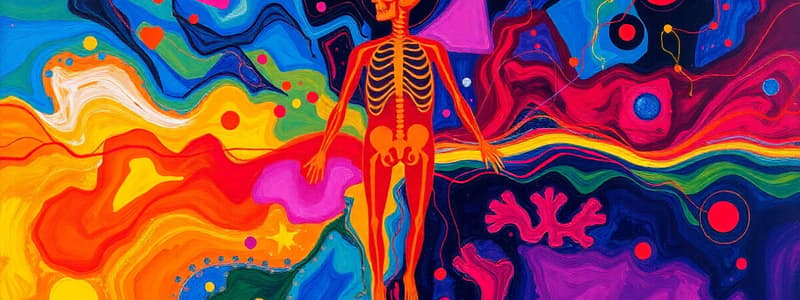Podcast
Questions and Answers
What part of the circulatory system allows for nutrient exchange?
What part of the circulatory system allows for nutrient exchange?
- Veins
- Arteries
- Vena Cava
- Capillaries (correct)
Which of the following is NOT a function of the circulatory system?
Which of the following is NOT a function of the circulatory system?
- Temperature control
- Transportation of nutrients
- Regulation of pH
- Production of red blood cells (correct)
What happens when a horse is too hot?
What happens when a horse is too hot?
- Blood vessels near the skin surface contract
- The horse shivers
- Blood vessels near the skin surface dilate (correct)
- Hair stands on end
What is the primary function of the hypothalamus in thermoregulation?
What is the primary function of the hypothalamus in thermoregulation?
Which of the following is an example of negative feedback in thermoregulation?
Which of the following is an example of negative feedback in thermoregulation?
What is the role of insulin in blood glucose regulation?
What is the role of insulin in blood glucose regulation?
What happens when blood glucose levels are too low?
What happens when blood glucose levels are too low?
Which of the following is NOT involved in osmoregulation?
Which of the following is NOT involved in osmoregulation?
What is the primary function of the tunica adventitia in an artery?
What is the primary function of the tunica adventitia in an artery?
Which of the following is NOT a component of the horse's heart?
Which of the following is NOT a component of the horse's heart?
What is the role of platelets in the blood?
What is the role of platelets in the blood?
Which hormone is responsible for regulating the production of other hormones in the pituitary gland?
Which hormone is responsible for regulating the production of other hormones in the pituitary gland?
What is the primary symptom of Cushing's disease in horses?
What is the primary symptom of Cushing's disease in horses?
Which of the following is a potential consequence of Cushing's disease in horses?
Which of the following is a potential consequence of Cushing's disease in horses?
What is the purpose of administering prascend to a horse with Cushing's disease?
What is the purpose of administering prascend to a horse with Cushing's disease?
Which dietary adjustments are recommended for a horse diagnosed with insulin resistance?
Which dietary adjustments are recommended for a horse diagnosed with insulin resistance?
Flashcards
Homeostasis
Homeostasis
The maintenance of internal regulation by negative feedback.
Thermoregulation
Thermoregulation
Temperature control by negative feedback in animals.
Hypothalamus
Hypothalamus
Brain region that detects temperature changes and initiates responses.
Osmoregulation
Osmoregulation
Signup and view all the flashcards
Blood Glucose Regulation
Blood Glucose Regulation
Signup and view all the flashcards
Circulatory System
Circulatory System
Signup and view all the flashcards
Capillaries
Capillaries
Signup and view all the flashcards
Vena Cava
Vena Cava
Signup and view all the flashcards
Arterial Layers
Arterial Layers
Signup and view all the flashcards
Function of Platelets
Function of Platelets
Signup and view all the flashcards
Effects of Hypertrichosis
Effects of Hypertrichosis
Signup and view all the flashcards
PPID
PPID
Signup and view all the flashcards
Horse's Heart Components
Horse's Heart Components
Signup and view all the flashcards
Diagnosis of PPID
Diagnosis of PPID
Signup and view all the flashcards
Insulin Resistance Test
Insulin Resistance Test
Signup and view all the flashcards
Study Notes
Homeostasis
- Homeostasis maintains internal regulation via negative feedback loops.
- Key control systems include thermoregulation, osmoregulation, and blood glucose regulation.
Thermoregulation
- Endothermic animals like horses maintain a constant body temperature (37.5°C).
- Hypothalamus detects blood temperature changes.
- Cooling Mechanisms: Dilation of blood vessels near the skin, sweating, behavioral changes (seeking shade, water). Hairs lay flat.
- Warming Mechanisms: Constriction of blood vessels near the skin, shivering, piloerection (hair standing on end). Release of internal fats.
Blood Glucose Regulation
- Negative feedback loop regulates blood glucose levels.
- High Blood Glucose: Pancreas releases insulin to store glucose.
- Low Blood Glucose: Liver releases glycogen, produces glucose from amino acids.
Osmoregulation
- Regulates water and electrolyte balance in the body.
Circulatory System
- Transports nutrients, waste, oxygen, carbon dioxide, hormones, regulates pH and temperature.
- Components: veins, arteries, capillaries, blood, heart.
- Capillaries: Thin walls for nutrient exchange and waste removal.
- Veins: Transport blood to the heart, contain valves to prevent backflow. (Largest- vena cava)
- Arteries: Transport oxygenated blood, thick walls; (e.g., pulmonary artery). Layers: tunica adventitia (outer), tunica media (middle), tunica intima (inner).
- Blood Composition: Erythrocytes (red blood cells), plasma, platelets, leukocytes (white blood cells).
- Platelets: Crucial for blood clotting.
- Heart: 4 chambers (right and left ventricle, right and left atrium). Pumps blood throughout the body. (4kg in a horse)
- Vena Cava transports deoxygenated blood to the heart.
- Aorta transports oxygenated blood.
Cushing's Disease (PPID)
- Cause: Endocrine dysfunction due to pituitary pars intermedia dysfunction, dysregulation of hormones. Dopamine, which regulates other hormones, decreases.
- Diagnosing: Clinical signs (hypertrichosis, weight loss, increased infections, laminitis, frequent urination) and ACTH blood test.
- Treatment: Prascend medication (FDA-approved). Preventative supplements:
- Nutritional: Increased amino acids (lysine, methionine, threonine), antioxidants, Omega-3 fatty acids, adaptogens.
- Insulin resistance assessment: Oral sugar tolerance test.
- Management: Reduce sugar and starch intake (reduced grain, grazing muzzles, soaked hay). Reduce treats. Use laminaze supplements.
Studying That Suits You
Use AI to generate personalized quizzes and flashcards to suit your learning preferences.




